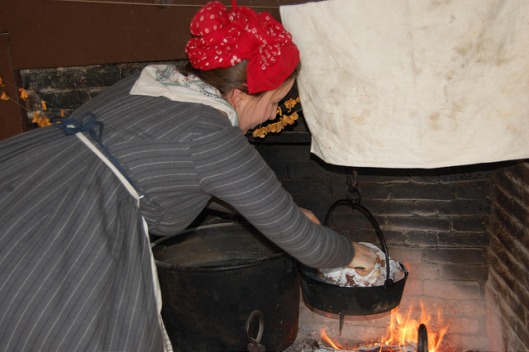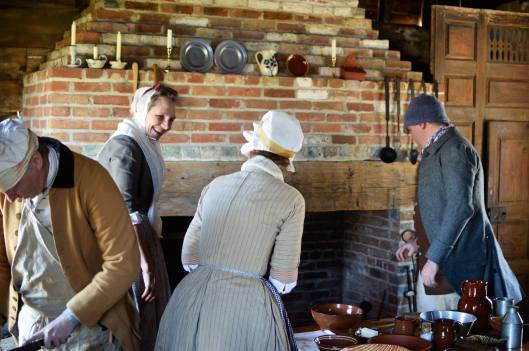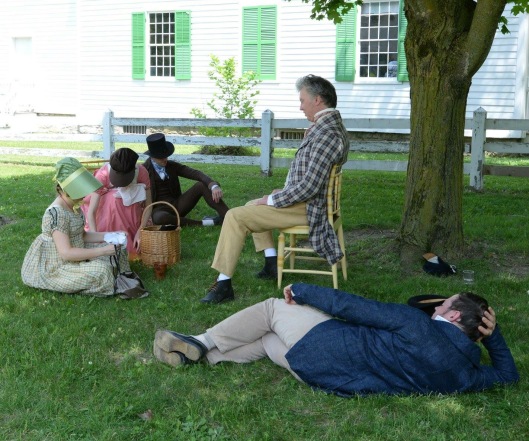A friend of mine recently wrote about replicating the domestic life of the past (specifically the 18th century) and how much meaning that had for her.
Being so deeply embedded in the rhythms of life there, it became my home in a very real sense that has never left me.
I read that quickly, and what I read was that the place she had spent so much time was home to her because the place never left her– she carried its rhythms and seasons within her. Perhaps that isn’t quite what she meant, but that’s the risk of writing: the reader reads what they need to.
It made me think of home, and of living deliberately, and of a very bad year I had a long time ago, before I even imagined doing living history, when I thought I would spend my life making new things, like cities and buildings. (This makes me think of an album I listened to at the time, More Songs About Buildings and Food, which seemed all the more important because I’d gone to RISD, too.
The year I turned 25 was particularly bad not because a man broke my heart, though that didn’t help, and not because I had a miscarriage, though that was the catalyst that led to the man breaking my heart, but because the miscarriage shattered my sense of purpose and self. Somehow, everything that I had ever wanted to be — a sculptor, an architect, a writer– was gone, and I didn’t know what to do or how to be. (Read The Year of Magical Thinking if you want a well-written take on this kind of loss.) I didn’t know what to do next, but the man who eventually broke my heart gave me a book to help me figure it out: Chop Wood, Carry Water
Two years ago, I wrote a piece called Zen and the Art of Living History, in which I extolled the virtue of the everyday: Embrace the everyday, bring everyone back into history. Since then, I’ve thought more about how history and historic house museums can be a catalyst for change, how domestic sites can create “homes for history,” where we can have the difficult conversations that must be had to make the change I think we need as a nation, and as humans. These changes are happening, slowly, in museums and at historic sites, but even at the personal level, there’s meaning and change to be had through the business of “doing history.”
I suspect that among the reasons people really enjoy immersive, civilian (non-musket) events is because the work brings them into the rhythms of the natural world in a way that industrial life precludes or even prohibits. Consciously or not, interpreting the domestic life of the past forces us into mindfulness, into being as much as or more than doing. That’s the point of “chop wood, carry water:” to live deliberately. To cook without a clock, with only the color of the coals and the smell of the food to guide you; to notice the changing light because, as it fades, you must act to create light; to find the flaws and shifts in a floor as you scrub it, because there’s no machine between you, just your hands and a brush or a mop: all these tasks force you to be in the moment, noticing your environment, noticing yourself. You. A corporeal presence in a material world. How does that feel, moment to moment? Physically, emotionally: the challenge of living in the past is to live an unmediated life.
To go back to basics the way we do with civilian or domestic-site based living history brings us back to our base: we face our physical needs and the challenge of meeting them. We face emotional tests that help us imagine how people in the past endured– I often wonder how everyday people coped with “melancholia,” grief, and disappointment– and help us endure. It brings us home to ourselves, to our individual histories and our shared histories, and that’s what really matters. The connection to the everyday that we experience in a place in time puts us in a continuum with the people of the past, and gives us a place to be, a thing to do, a meaning. And that is what every one of us needs.






“Being so deeply embedded in the rhythms of life there, it became my home in a very real sense that has never left me.”
“I read that quickly, and what I read was that the place she had spent so much time was home to her because the place never left her– she carried its rhythms and seasons within her. Perhaps that isn’t quite what she meant…”
Well, no it wasn’t what I meant, or at least it wasn’t the point I was trying to make. But it is certainly also true. I do carry that place with me wherever I go, and I left some part of my self there forever.
But I wouldn’t go too far with glorifying the ‘mindfulness’ of pre-industrial domestic life. They would have called it drudgery.
They would also have called it ordinary.
And that probably *was* my point. We cannot hope to understand life in the 18th century until we have experienced and internalized its ordinary aspects so thoroughly that they are instinctive to us.
Which is why so few of us will ever understand life in the 18th century: very few people really get the extended experience. Most of us will have to use mindfulness — hyper awareness of the moments we are close to the 18th century— to bridge the gap. If we examine our experiences afterward, we can use them better.
While reading your post, I kept thinking about the children who died young, or unborn, in the past. How every grieving mother would also have lost siblings early on, and her own siblings, neighbors, and friends had also lost children. So much grief, but also the knowledge that everyone around you understood very well what you were going through.
Love this piece! For me, mindfulness is about connection–to the physical world, to the body, to the past, to the present. Maybe that’s why I’m so interested in/obsessed with my own past and how I got here, wherever here is at the moment. Google, Facebook, etc. are wonderful tools, and I use them all the time, but there is a real loss, I think, in not thumbing through card catalogs and walking through shelves to find what you need, for example. But as you suggest, you can get closer than that through household work, cooking, watering plants (though just using a hose is a disconnection from water and its source), In the big picture all of “progress” has been about distancing ourselves from the physical world, from the blessed gravity of time, from the inevitable reality of our return to earth or ash.
Pingback: Dresstory: The Turnabout Skirt | Kitty Calash